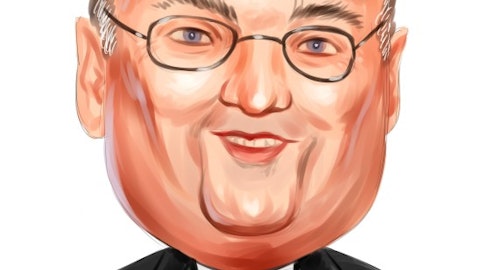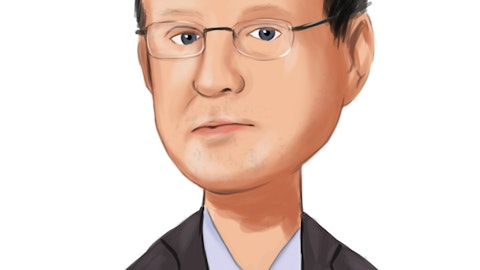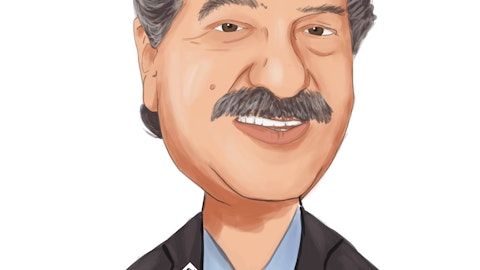Virtus Investment Partners, Inc. (NASDAQ:VRTS) Q4 2022 Earnings Call Transcript February 3, 2023
Operator: Good morning. My name is Michelle, and I will be your conference operator today. I would like to welcome everyone to Virtus Investment Partners Quarterly Conference Call. The slide presentation for this call is available in the Investor Relations section of the Virtus website at www.virtus.com. This call is being recorded and will be available for replay on Virtus website. At this time all participants are in listen-only mode. After the speakers’ remarks, there will be a question-and-answer period, and instructions will follow at that time. I will now turn the conference over to your host, Sean Rourke.
Sean Rourke: Thanks, Michelle. And good morning, everyone. On behalf of Virtus Investment Partners, I’d like to welcome you to the discussion of our operating and financial results for the fourth quarter of 2022. Our speakers today, are George Aylward, President and CEO and Mike Angerthal, Chief Financial Officer. Following their prepared remarks, we will have a Q&A period. Before we begin, please note the disclosures on Page 2 of the slide presentation. Certain matters discussed on this call may contain forward-looking statements within the meaning of the Private Securities Litigation Reform Act of 1995. And as such are subject to known and unknown risks, and uncertainties including but not limited to those factors set forth in today’s news release and discussed in our SEC filings.
These risks and uncertainties may cause actual results to differ materially from those discussed in the statements. In addition to results presented on a GAAP basis, we have certain non-GAAP measures to evaluate our financial results. Our non-GAAP financial measures are not substitutes for GAAP financial results and should be read in conjunction with the GAAP results. Reconciliations of these non-GAAP financial measures to the applicable GAAP measures are included in today’s news release and financial supplement, which are available on our website. Now, I’d like to turn the call over to George. George?
George Aylward: Thank you, Sean. Good morning, everyone. I will start with an overview of the results we reported earlier today before turning it over to Mike to provide more detail. The fourth quarter remain challenging, consistent with the trends throughout the year. In addition to a volatile market and heightened uncertainty, open end fund flows industry wide were particularly negative, most notably in December, as investor sentiment driven activity resulted in and among the most elevated fund net outflows than what was already historically difficult year. Well, we had net outflows in the quarter due to higher redemptions. We did have a meaningful increase in sales across products and asset classes, positive institutional net flows, a higher average fee rate which has been resilient despite industry trends, continued solid investment performance, and significant balance sheet flexibility and a net cash position at December 31.
We have built our organization to navigate challenging environments like these and our position for market stabilization recovery with increasingly well diversified products and capabilities that can attract assets across market cycles and changing investor preferences. We continue to be focused on the execution of our strategy and building out capabilities to position us for future growth as the environment improves. Turning now to review the results. Total assets under management increased 3% to $149 billion, primarily due to market appreciation partially offset by net outflows. Sales increased 27% to $7.3 billion with increases across all product types and most asset classes. Institutional sales doubled to $3 billion, benefiting from a large inflow into an existing mandate, contributions from non-U.S. clients and the issuance of the new CLO.
Retail sales also increased with open end funds up 5% due to higher sales of equity, fixed income and alternative strategies, and retail separate accounts rose 4% due to investment grade fixed income. Net outflows were $3.4 billion, essentially unchanged from the prior quarter and again, primarily due to elevated redemptions. Net outflows were primarily in mutual funds, consistent with industry trends, but also included in net outflows in the intermediary distributed retail separate accounts, while institutional and private client generated positive net flows. By product, institutional net flows were positive $0.8 billion, reflecting the meaningful increase to a domestic large cap growth equity mandate, and $300 million from the issuance of the CLO.
Institutional net flows have been positive in eight of the last nine quarters and considering the challenging environment we are pleased with this consistent level of activity. But net outflows of $3.8 billion were elevated, in line with market trends and were particularly negative in the month of December. Retail separate account net flows were again negative due to higher redemptions, reflecting retail investor sentiment. In terms of what we saw in January, mutual fund net flows was still negative improved meaningfully from the fourth quarter and represented the best month of flows since September of 2021, including improvements in both sales and redemption rates. In particular, we saw positive net flows in our international global products, as well as certain of our small cap and fixed income products.
The institutional pipeline remains strong with known wins, exceeding known redemptions over the next two quarters. Our fourth quarter financial results again reflected the impact of market declines over the course of the year. Operating income as adjusted was $56 million, down from $65 million sequentially, and the related margin of 31.8%, declined from 35% due to lower revenues and relatively stable operating expenses. Earnings per share as adjusted decreased 10% to $5.17, reflecting the the impact of decline in average assets under management. Turning now to capital. Given our solid cash flow generation and balance sheet, we continue to return capital to shareholders, while maintaining appropriate levels of working capital and leverage. During the quarter, we’ve repurchase 10 million of our common shares, totaling 90 million for the full year, and we’ve reduced shares outstanding by 4.3% in 2022.

Photo by Austin Kehmeier on Unsplash
We ended the quarter in net cash position of $77 million and continue to have significant flexibility in managing our capital needs, with total cash on hand at year end of $338 million, a $175 million undrawn revolver, and $128 million in investments, providing ongoing flexibility to invest in the business and continue to return capital to shareholders. Before I turn the call over to Mike, I would like to provide a brief update on our agreement to add AlphaSimplex, a leading provider of liquid alternative investment solutions as an affiliated manager. As we’ve discussed previously, AlphaSimplex will enhance and diversify our investment offerings, provide additional product and distribution growth opportunities and expand our presence in the alternatives category.
The transaction which we expect to close near the end of the first quarter will be funded with existing balance sheet resources that include our undrawn credit facility. We expect it to be immediately accretive to earnings consistent with the 10% level we previously provided. Given the timing of the close, the first quarter outlook Mike will provide for various metrics will not include the impact of the transaction. We will update you on the modeling for AlphaSimplex and its impact on our outlook on the next call. With that I’ll turn the call over to Mike, Mike?
Mike Angerthal: Thank you, George. Good morning, everyone. Starting with our results on Slide 7, Assets Under Management. At December 31, assets under management were $149.4 billion, up 3% from $145 billion at September 30. The sequential change reflected $8.8 billion of market appreciation and $3.4 billion of net outflows. Average assets under management in the quarter were $148.6 billion, down 5% due to market performance and net outflows. Our assets under management remained well diversified by product type and asset class. Institutional represented 34% of total AUM at December 31, with U.S. retail funds, and retail separate accounts at 32% and 24%, respectively. By asset class, equity was 55%, fixed Income and multi asset strategies were combined 38% and alternatives were 7% of AUM.
We continue to generate strong relative investment performance across strategies. At December 31, approximately 57% of rated fund assets had four or five stars, and 90% were in three, four or five star funds. We had nine funds with AUM of $1 billion or more that were rated four or five stars, representing a diverse set of strategies from five different managers. On a five year basis, 75% of our rated fund AUM was outperforming to median performance of their peer groups. In addition to strong fund performance, as of December 31, 87% of retail separate account assets and 61% of institutional assets were outperforming their benchmarks over five years. Also 57% of institutional assets were exceeding the median performance of the peer groups on the same five year basis.
Turning to Slide 8, Asset Flows. Total sales increased by 27% to $7.3 billion, reflecting growth in each product, particularly institutional. By product, institutional sales were $3 billion, up from $1.5 billion in the third quarter, due to a significant additional funding into a domestic large cap growth equity mandate, in addition to the $300 million CLO issuance. Fund sales of $3 billion increased 5% with particularly strong growth and alternatives, domestic small cap and global equity. Retail separate account sales of $1.2 billion increased 4% largely driven by investment grade fixed income. Total Net outflows were $3.4 billion, primarily due to open end funds. Reviewing by product, institutional generated positive net flows of $0.8 billion, with meaningful contributions from non-U.S. clients.
Strengthened non-U.S. came from multiple affiliates, and included both new mandates and fundings to existing accounts. For open end funds, net outflows were $3.8 million, up from $2.8 billion in the third quarter due to elevated redemptions and consistent with negative retail trends. In retail separate accounts, net outflows of $0.4 billion, compared with $0.2 billion in the third quarter, with investment grade generating positive net flows. In our private client business net flows remained positive as they have for 16 consecutive quarters. Turning to Slide 9, investment management fees as adjusted of $156.1 million, declined $7.9 million or 5%, reflecting the 5% sequential decline in average assets under management. The average fee rate of 41.7 basis points compared with 41.5 basis points in the prior quarter.
The fee rate increased modestly on a sequential basis for each product category. And on an overall basis, the fee rate has remained in the 41 to 42 basis points range over the course of 2022. Performance fees in the quarter were $0.5 million, up from $0.3 million in the prior quarter, favorably impacting the fee rate by 0.1 basis points in both periods. Looking forward into the first quarter, we believe the range of 41 to 43 basis points remains reasonable. Slide 10 shows the five quarter trend and employment expenses. Total employment expenses as adjusted of $88.3 million, decreased sequentially from $88.7 million. Lower profit and sales based compensation was partially offset by market valuation adjustments and investment related compensation utilized in deferred plans.
These valuation adjustments are hedged and fully offset by a corresponding amount included in other income. As a percentage of revenues, employment expenses were 50.1%, up from 47.8% in the third quarter, primarily due to lower revenue. For the first quarter, the fourth quarter ratio would be a reasonable level to expect. Though I would note, it will be subject to variability based on market performance profits and sales. For modeling purposes, the first quarter will also include seasonal employment expenses which are incremental to this outlook. Turning to Slide 11, other operating expenses as adjusted were $30.8 million and compared with $31.1 million in the prior quarter, which included approximately $1 million of costs associated with the AlphaSimplex transaction.
Excluding these transaction costs, from the prior period, other operating expenses as adjusted increased by $0.7 million or 2.3%, largely due to higher sales and marketing activity, which continues to normalize as well as efficiency and distribution initiatives. For the first quarter of 2023, we anticipate other operating expenses as adjusted will be at a similar level as the past three quarters. We continue to closely manage all discretionary expenditures and initiatives. While our expenses have been impacted by inflationary pressure, increasing costs of contracts with key vendors, service providers and suppliers, as well as by the ongoing resumption of sales activity toward more normalized levels, our focus on discretionary spending has generally offset those increases, allowing us to maintain other operating expenses at a relatively stable level over the past several quarters.
In addition, our expense management efforts have supported our ability to continue to invest in select strategic initiatives that we expect will benefit future operating leverage and expand our growth capabilities. Slide 12 illustrates the trend in earnings. Operating income as adjusted of $56.1 million, declined $8.8 million or 14% sequentially due to lower revenues. The operating margin as adjusted of 31.8% compared with 35% in the third quarter. Net income as adjusted of $5.17 per diluted share declined 10% from the prior quarter. Regarding GAAP results, net income per share of $4.77, increased from $4.25 per share in the third quarter, and included $1.53 benefit from the fair value adjustments to affiliate non-controlling interests and $0.78 of net realized and unrealized gains on investments partially offset by $1.03 of CLO issuance expense, $0.50 of negative fair value adjustments to contingent consideration and $0.41 of discrete tax adjustments.
Slide 13 shows the trend of our capital liquidity and select balance sheet items. Working Capital was $181 million at December 31, down from $195 million at September 30, as an investment and our new CLO and return of capital to shareholders exceeded cash earnings. Contingent consideration which includes estimated revenue participation at earn out payments was $128 million at December 31, down sequentially from $134 million. This amount will vary over time, based on changes in the underlying related revenue streams. During the fourth quarter, we repurchased 53,320 shares of common stock for $10 million. And over the past year, we have reduced shares outstanding by 4.3%. At December 31 gross debt to EBITDA was 0.8 times and net cash of $77 million increased from $47 million at September 31.
First quarter 2023 cash obligations include payment of annual incentives, seasonal employment expenses, a revenue participation payment, and as mentioned, we expect to close an AlphaSimplex near the end of the quarter. With that, let me turn the call back over to George, George?
George Aylward: Thank you, Mike. We will now take your questions. Michelle, would you open up the line please?
See also 10 Hot Insurance Stocks To Buy Now and 25 Fastest Cars in the World.
Q&A Session
Follow Virtus Investment Partners Inc. (NASDAQ:VRTS)
Follow Virtus Investment Partners Inc. (NASDAQ:VRTS)
Operator: Thank you. And our first question comes from the line of Sumeet Mody with Piper Sandler. Your line is open. Please go ahead.
Sumeet Mody : Thanks. Good morning, guys. So nice to hear retail flow starting off well for the year, sorry if I missed this. Can you guys talk about what you’re seeing on the institutional and SMA channels as well in January so far?
George Aylward : Sure. So for mutual funds, so we commented on the month of January and after really challenging 2022, in particular December was very nice when we close out January that on — in terms of the level of even sales rate or redemption rate, as well as in terms of overall dollars, as I noted was the best month is September of 2021. So that was really good to see. We particularly seeing some categories like international and global actually as a category in the fund set kind of be positive as well as the select areas of strength within some of the small caps but not all of them and as well as some of the fixed income. And though I have more optimism for fixed income later on in the year, hopefully. Institutional, pipeline remains strong.
That’s been a lot of area of focus for us where we put our attention and our resources and several of our initiatives are related to maximizing that. So we’re really happy to see the consistency of what’s in a lumpy business. Though it’s still generating strong levels over the nine quarters, we’ve noted eight have been positive, pipeline is good. The non-U.S. concentration continues to get a little bit better. So that was something we were underweight several years ago, but they’ve now become significant contributors. And that’s across affiliates and across strategies. So that’s great to see. On the retail separate account side, given the nature of that business, particularly the intermediary retail channel, where some of the strategies are, are really sort of either done model only, or through other provisions.
We don’t have as much real time access to some of that information. But generally, because as that business is concentrated in our equity strategy, particularly growth and smaller cap, mid cap kind of strategies, it’s going to go with a broader market. So I think what you saw in the fourth quarter for that, it was really just reflective of the sentiment on those equity strategies. And while we have a smaller piece that’s in fixed income, that’s where you kind of saw a little bit of an uptick in the January comment.
Sumeet Mody : Great, thanks, really helpful. And then on the AlphaSimplex transaction, what was the AUM two and the year for that? And can you maybe talk about some of the demand you’re seeing on the institutional side, specifically for them, and how that’s been going to start the year as well?
Mike Angerthal : Yeah, so for AlphaSimplex, until we close, we’re not going to make comments on their business or their business results. Obviously, they’re part of another company. So we’re not going to comment on that. But we’re continuing to do a lot of work related to the preparation of the integration. Very excited about having them as an addition to the family of boutiques. The great team over there. We spent a lot of time internally here, thinking about ways to leverage their capabilities and their expertise. Again, they’re in the alternative space. So in the periods in the beginning of the year, last year, where traditional strategies were underperforming, they were outperforming. So again, there’ll be — meant to be, will have a of gold to some of our more correlated strategies.
But we’re really excited about the opportunity for us to sort of apply what they can do across a whole host of things. And they’re still, in our view best-in-class in terms of what they do.




